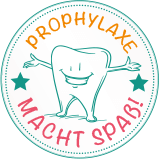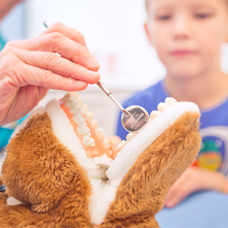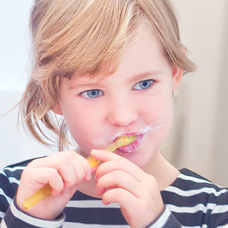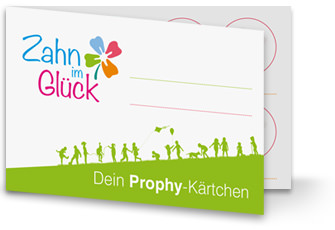
Prophylaxis – The Best Cavity Protection for Children
Protect your teeth like you protect yourself!
Staying healthy—both orally and physically—is easier than you think. Here are five steps the pediatric dentists at Zahn im Glück recommend to best protect your child from cavities:
1. Learning to brush – the proper and fun way

The earlier your child gets used to brushing, the better. In our cozy “toothbrushing school,” we teach kids how and why to brush properly—even baby teeth.
Children quickly develop a sense of responsibility for their dental health. Parents might even learn something too!
2. Cavity-Preventing Nutrition – Simpler Than You Think
Detailed advice is available in our separate Nutrition Counseling section
3. Fluoride – Yes, but Safely and Age-Appropriate
Many parents are cautious about fluoride, but it’s a natural trace element found in fruits, vegetables, dairy, and water.

Fluoride:
- Helps rebuild enamel (remineralization)
- Protects against demineralization from acidic foods
We advise on fluoride toothpaste based on your child’s age and needs.
Recommended daily fluoride intake:
- 0–4 months: 0.25 mg
- 4–12 months: 0.5 mg
- Toddlers: 0.7–1.1 mg
- Schoolchildren: 1.1–2 mg
- Teen boys: 3.2 mg | Teen girls: 2.9 mg
- Adults (m): 3.8 mg | Adults (f): 3.1 mg
- Pregnant/breastfeeding women: 3.1 mg
It’s important to regulate fluoride intake according to age.
A low-fluoride toothpaste for children plays an essential role in this.
We’re happy to advise you and explain what to look out for when choosing the right toothpaste for your child.
4. Professional Cleanings Make Your Child a Pro

Prophylaxis generally refers to the prevention of diseases in the mouth and throughout the body. For children with healthy teeth, one prophylaxis appointment every six months is usually enough to help prevent cavities. During professional dental cleanings, we gently but thoroughly clean children's teeth—especially in areas that are hard to reach with a toothbrush at home. We remove stubborn plaque and clean between the teeth, as cavities tend to develop easily in these areas.
With regular professional dental cleanings at our practice, your child can discover how pleasant a visit to the dentist can be. Through playful conversations with our dentists and fun learning in our “toothbrushing school,” your child develops an early awareness of the importance of their own dental health.
5. Fissure Sealants – Smoother chewing surfaces mean less room for cavities
The deep grooves on the chewing surfaces of molars are called fissures. These grooves can vary in depth and shape from person to person. Smooth chewing surfaces are easier to clean, while uneven ones provide more hiding spots for cavities to develop unnoticed. If your child’s molars have particularly irregular surfaces, we recommend applying a fissure sealant. Health insurance covers the cost of sealing the large permanent molars. Unfortunately, sealing the smaller baby molars is not yet covered.
Still, depending on the tooth surface, we may recommend sealing certain baby teeth as well. Sealants smooth out the deep grooves in the tooth, making it easier to keep the teeth clean. After all, cavities in baby teeth can be just as harmful to your child’s well-being—and the development of their future permanent teeth—as cavities in adult teeth.
Sealants – starting with the first molar
As soon as the chewing surface of a tooth has fully erupted—that is, no longer covered by gum tissue—it can be sealed. We especially recommend sealing right after the tooth erupts, as the enamel hasn’t fully matured yet.
At this stage, teeth are particularly vulnerable to cavities. If the tooth hasn't fully come through yet, we can still protect it using cavity-preventive varnishes and an initial prophylaxis treatment.
During your child’s first visit to our practice in Munich, and after a thorough examination, we’ll take the time to discuss what’s most suitable for your child in a calm and caring environment.
Your Questions About Prophylaxis
What does prophylaxis mean?
Prophylaxis means prevention. Through regular check-ups every six months, along with personalized advice and tips for home care, we aim to help prevent cavities from developing in your child’s teeth.
What does prophylaxis look like for children?
During a prophylaxis appointment, we assess your child’s oral hygiene status and provide tailored oral hygiene instructions. This includes guidance on the right toothbrush, toothpaste, and dental floss, as well as biannual fluoride treatments.
What’s the difference between prophylaxis and a dental cleaning?
Prophylaxis should not be confused with professional dental cleaning. During a cleaning, a trained dental professional removes tartar, stains, and buildup using special hand and polishing instruments. Depending on your child’s tendency to develop tartar, we recommend this treatment every six or three months.
Dental cleanings can easily be scheduled together with the routine check-up and prophylaxis appointment. We also use the time during cleaning sessions to teach your child how to properly brush their teeth using their own toothbrush.
Is prophylaxis painful for children?
Not at all! Prophylaxis and professional cleanings are completely pain-free. In fact, they often help children develop positive and confident experiences at the dentist.
Which services are covered by health insurance for children?
Statutory health insurance in Germany covers the following preventive services twice a year:
- IP1: Oral hygiene status assessment
- IP2: Oral hygiene instruction
- IP4: Local fluoride application
Please note: professional dental cleanings are not covered by health insurance.